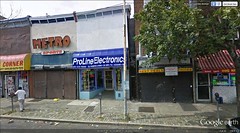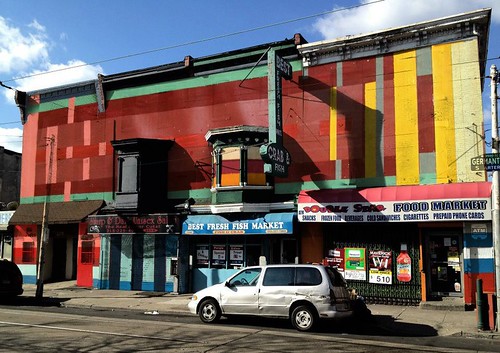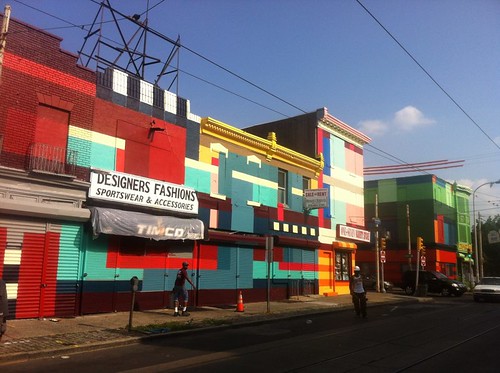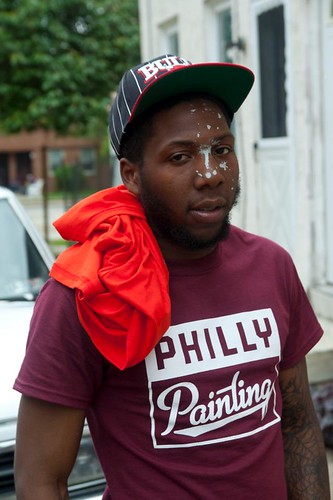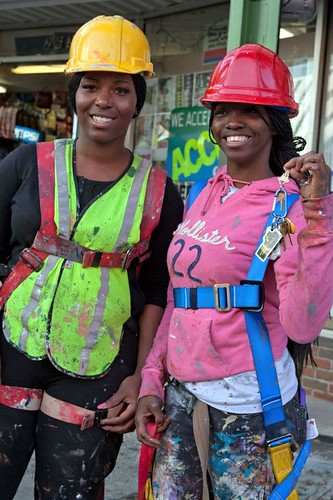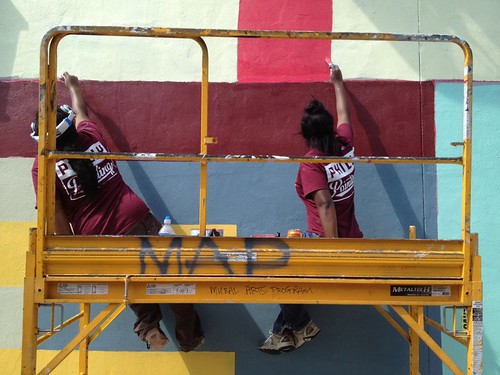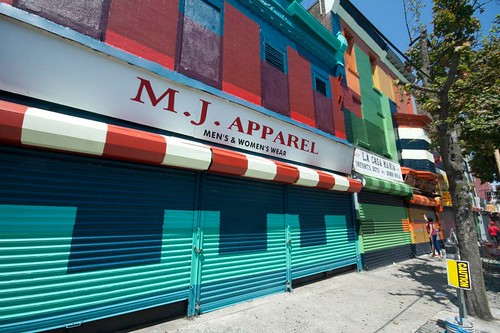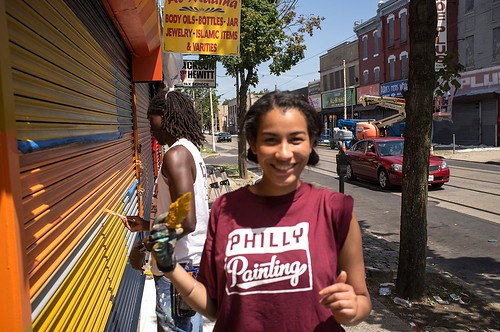How Public Art Improves the Economic and Social Environment
Earlier this year, I wrote about how some neighborhoods were building community through creative street painting. But, as a tough Philadelphia neighborhood is vividly demonstrating, one can look up as well as down when wielding a paintbrush. What this community is doing with colorful, large-scale murals on its main drag is really impressive, and I think it has the potential to make a big difference.
Philly Painting, as the project is known, is "a neighborhood beautification project of unprecedented scale," according to its website. "The goal is to mobilize the community to completely transform the commercial corridor and bring a new look to their neighborhood: A social and artistic experiment of urban acupuncture, beautification, and economic stimulus." You gotta like "urban acupuncture," right?
The project is set in North Philadelphia, on a four-block stretch of Germantown Avenue between Huntingdon Street and Somerset, including the principal intersection at West Lehigh Avenue. Although once thriving, the corridor has become plagued with all the troubling symptoms of disinvestment, including abandoned and now-fortified buildings, sidewalks strewn with trash, boarded-up windows, and crime.
But all you have to is look at the photos to get a sense of how Philly Painting is completely transforming the look of the Avenue, bringing a radiant sense of identity that can not only generate pride in the neighborhood but also create a destination. Several new businesses have opened up, according to reports, and the neighborhood is even beginning to attract visitors who want to see the murals. Philly Painting brings to mind other places where public art is being used in wonderful ways to bring people together give a boost to revitalization, such as Houston's Project Row Houses, LA's Watts House Project, Detroit's Heidelberg Project, and the interactive "Before I Die" project that artist Candy Chang began in New Orleans and has now taken to other cities.
I believe strongly that a thriving inner-city cultural environment contributes to a healthy economic and social environment, which in turn produces significant benefits to the things we value in our natural environment: this is because the most effective antidote to the kind of sprawling outward development that has consumed our landscape, polluted our waterways and escalated harmful emissions across the US over the past half-century is a strengthening of our existing communities. We particularly need our inner cities to be the kinds of places that will be loved and will endure – that will literally be sustained - over time. The human ecosystem is complex and, while making it healthy also requires a lot of things besides art, a holistic approach to placemaking that includes a key role for culture – especially homegrown culture – is essential.
That, it appears to me, is exactly what Philly Painting is doing. To date, it is the most ambitious of many great projects sponsored by Philadelphia's Mural Arts Program, the nation's largest initiative of its kind. Since 1984, the program has created over 3,000 murals and works of public art in the city, engaging over 100 communities each year in the process, according to its website. Mural Arts also sponsors free art education programs for youth, especially at-risk teens and, impressively,provides jobs to adult offenders in local prisons and rehabilitation centers, "using the restorative power of art to break the cycle of crime and violence in our communities." If you are as interested in this sort of thing as I am, you'll enjoy the program's website, especially its sections on the program's history and emphasis on community engagement.
Artistically, Philly Painting is being guided by Dutch artists Jeroen Koolhaas and Dre Urhahn ("Haas & Hahn"), best known for using public art to transform the favelas in Rio de Janeiro. Haas & Hahn have worked closely with local partners and the businesses along Germantown Avenue, customizing particular patterns and colors to suit their needs. The painting project is also coordinated with a larger economic development strategy involving the city's Department of Commerce, and with the NET Community Development Corporation, which works in the neighborhood. According to the Mural Arts Program's narrative, the project is engaging seven local apprentices and five full-time crew members, with additional residents and small businesses participating in production and marketing.
Marketing, of course, is a big part of the project's mission:
"Ultimately, Haas & Hahn want to bring people into the community -- customers to the local business, more businesses to the street and more people employed through both the efforts and results of the transformation. They want to help make the neighborhood the vibrant place it once was. They see the project as an urban experiment, to see what happens to the post-modern American city and to see how we value and define our neighborhoods, essentially using the project "to market the community." The artists have also developed a project logo that they plan to have copyrighted to the zip code, so that local merchants can take advantage of the increased attendance in the area."
I love the spirit of innovation in Philadelphia right now, from the city's leadership in green stormwater infrastructure to the reclamation of vacant lots for neighborhood green space, from the new "front porch" at the train station to the city's overall sustainability plan. Philly Painting can be seen as an extension of these efforts, and a highly creative one.
There's no question that the people in the neighborhood are engaged and excited. The project has a weekly video blog with, I think, eight entries so far. I loved them all, and only had trouble picking just one to show you as in introduction. But Reggie Butta's enthusiasm is this one makes it a must-see. Enjoy:



